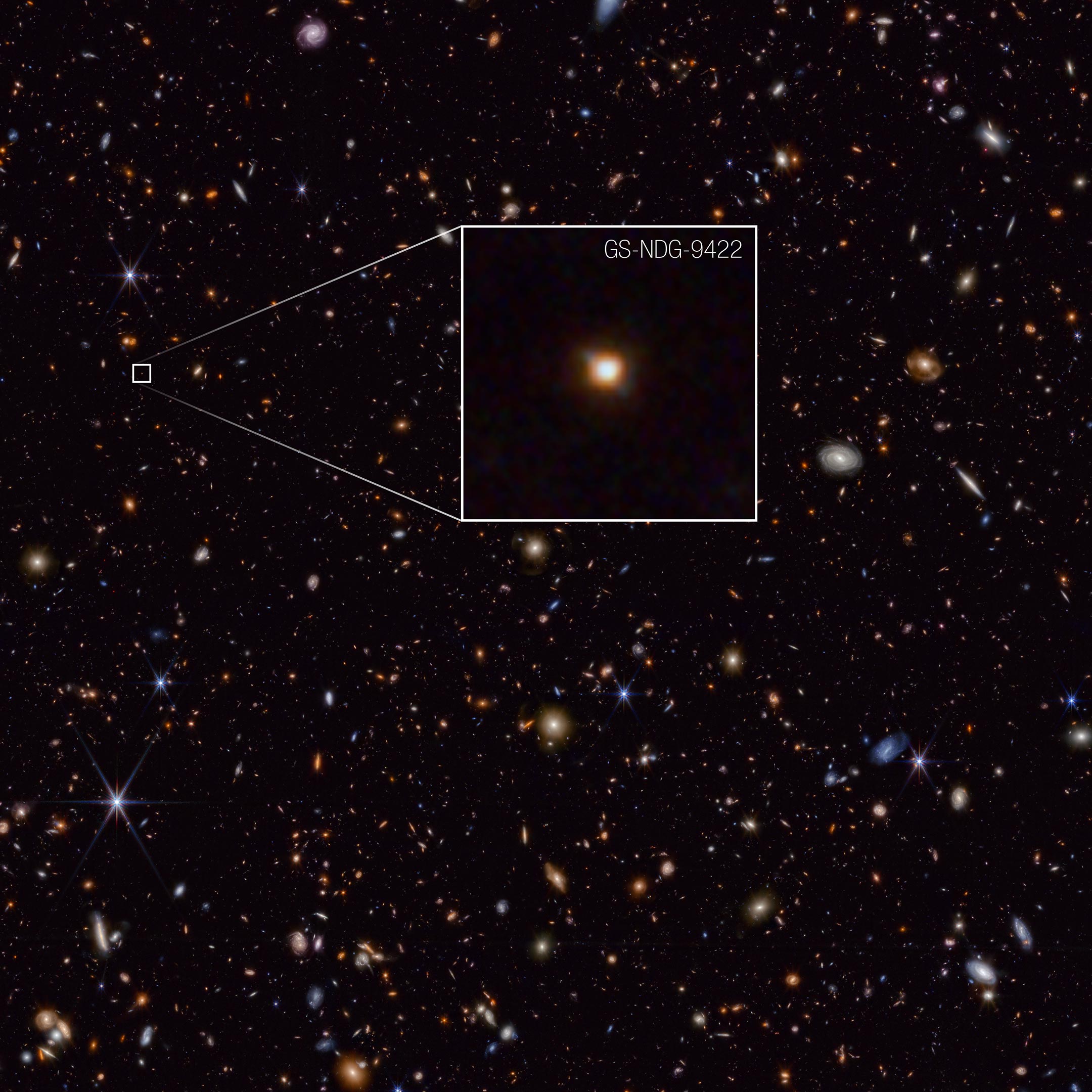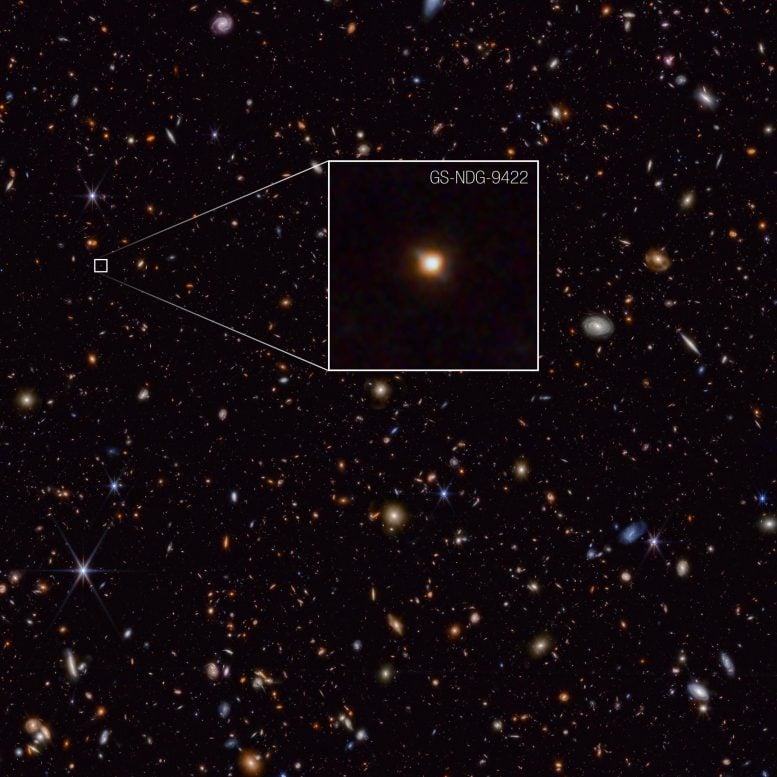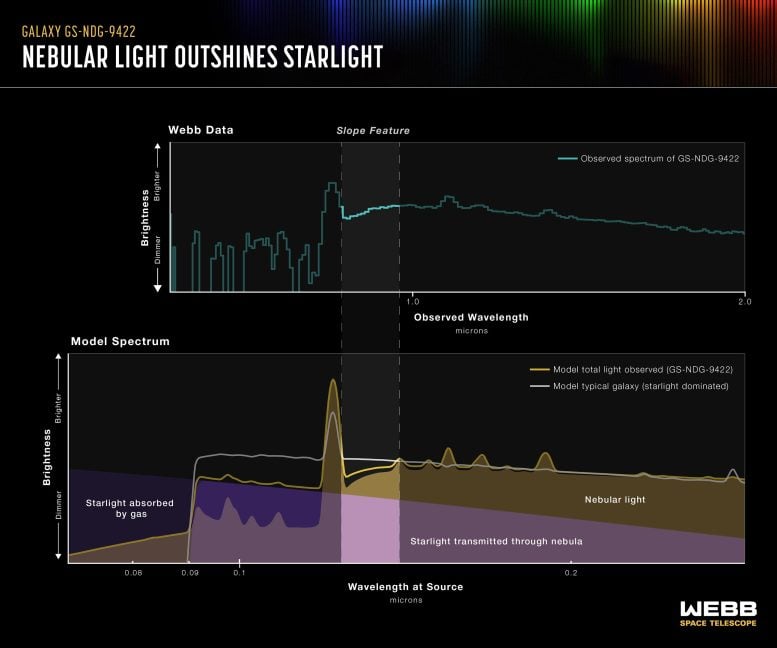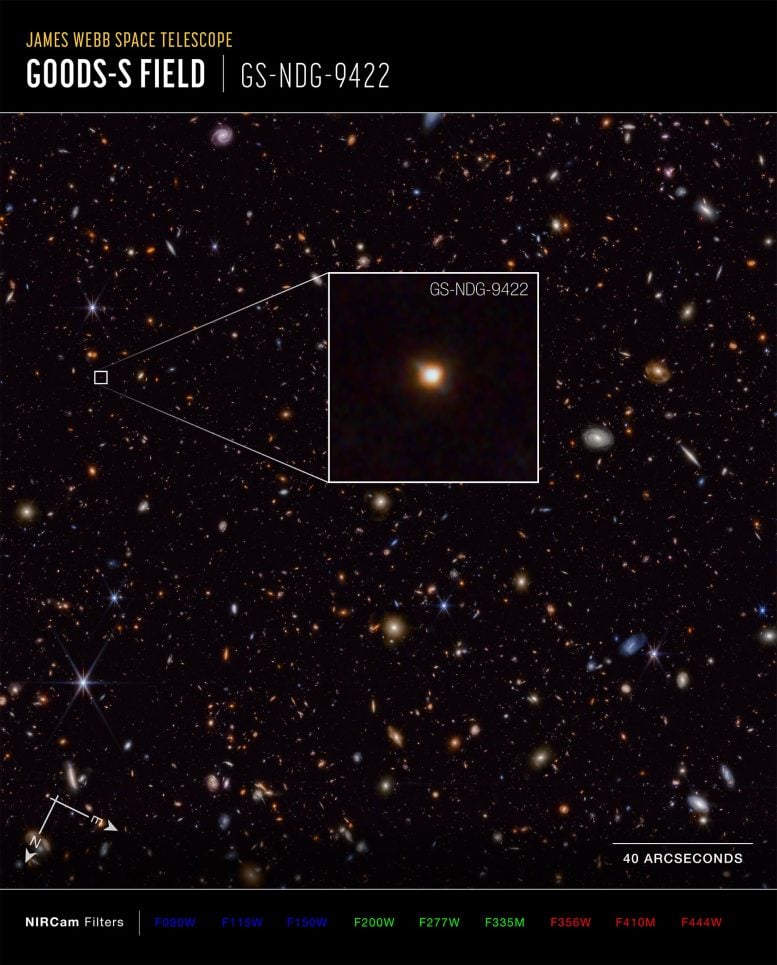

With its gas shining brighter than its stars, a strange galaxy found one billion years after the Big Bang may represent a previously unknown phase of galactic evolution.
Amid a crowded field of galaxies captured by NASA’s James Webb Space Telescope, one otherwise inconspicuous galaxy stands out for emitting a light signature that astronomers have never seen before. Together, an observational astronomer and a theorist investigated potential causes. They concluded that the strange spectrum of galaxy GS-NDG-9422 is likely coming from its super-heated gas, not its stars.
This intriguing conclusion opens up several future paths for investigation, including the connection between this odd galaxy and the universe’s first generation of stars – also predicted to be outshone by nebular gas.
In Odd Galaxy, Webb Space Telescope Finds Potential Missing Link to First Stars
Astronomers have found something unprecedented while looking deep into the early universe with NASA’s James Webb Space Telescope. They discovered a galaxy with an odd light signature, which they attribute to its gas outshining its stars. Found approximately one billion years after the Big Bang, galaxy GS-NDG-9422 (9422) may be a missing-link phase of galactic evolution between the universe’s first stars and familiar, well-established galaxies.
“My first thought in looking at the galaxy’s spectrum was, ‘that’s weird,’ which is exactly what the Webb telescope was designed to reveal: totally new phenomena in the early universe that will help us understand how the cosmic story began,” said lead researcher Alex Cameron of the University of Oxford.

The bottom graphic compares what astronomers would expect to see in a “typical” galaxy, with its light coming predominantly from stars (white line), with a theoretical model of light coming from hot nebular gas, outshining stars (yellow line). The model comes from Cameron’s collaborator, theoretical astronomer Harley Katz, and together they realized the similarities between the model and Cameron’s Webb observations of galaxy GS-NDG-9422 (top). The unusual downturn of the galaxy’s spectrum, leading to an exaggerated spike in neutral hydrogen, is nearly a perfect match to Katz’s model of a spectrum dominated by super-heated gas.
While this is still only one example, Cameron, Katz, and their fellow researchers think the conclusion that galaxy GS-NDG-9422 is dominated by nebular light, rather than starlight, is their strongest jumping-off point for future investigation. They are looking for more galaxies around the same one-billion-year mark in the universe’s history, hoping to find more examples of a new type of galaxy, a missing link in the history of galactic evolution.
Credit: NASA, ESA, CSA, Leah Hustak (STScI)
Theoretical Insights and Observations
Cameron reached out to colleague Harley Katz, a theorist, to discuss the strange data. Working together, their team found that computer models of cosmic gas clouds heated by very hot, massive stars, to an extent that the gas shone brighter than the stars, was nearly a perfect match to Webb’s observations.
“It looks like these stars must be much hotter and more massive than what we see in the local universe, which makes sense because the early universe was a very different environment,” said Katz, of Oxford and the University of Chicago.
Properties of Galaxy 9422
In the local universe, typical hot, massive stars have a temperature ranging between 70,000 to 90,000 degrees Fahrenheit (40,000 to 50,000 degrees Celsius). According to the team, galaxy 9422 has stars hotter than 140,000 degrees Fahrenheit (80,000 degrees Celsius).
The research team suspects that the galaxy is in the midst of a brief phase of intense star formation inside a cloud of dense gas that is producing a large number of massive, hot stars. The gas cloud is being hit with so many photons of light from the stars that it is shining extremely brightly.

This image shows near-infrared wavelengths of light that have been translated into visible-light colors. The color key shows which filters were used when collecting the light. The color of each filter name is the visible light color used to represent the infrared light that passes through that filter.
Credit: NASA, ESA, CSA, STScI, Alex Cameron (Oxford)
Implications for Cosmic Evolution
In addition to its novelty, nebular gas outshining stars is intriguing because it is something predicted in the environments of the universe’s first generation of stars, which astronomers classify as Population III stars.
“We know that this galaxy does not have Population III stars, because the Webb data shows too much chemical complexity. However, its stars are different than what we are familiar with – the exotic stars in this galaxy could be a guide for understanding how galaxies transitioned from primordial stars to the types of galaxies we already know,” said Katz.
At this point, galaxy 9422 is one example of this phase of galaxy development, so there are still many questions to be answered. Are these conditions common in galaxies at this time period, or a rare occurrence? What more can they tell us about even earlier phases of galaxy evolution? Cameron, Katz, and their research colleagues are actively identifying more galaxies to add to this population to better understand what was happening in the universe within the first billion years after the Big Bang.
“It’s a very exciting time, to be able to use the Webb telescope to explore this time in the universe that was once inaccessible,” Cameron said. “We are just at the beginning of new discoveries and understanding.”
The research paper is published in Monthly Notices of the Royal Astronomical Society.
Reference: “Nebular dominated galaxies: insights into the stellar initial mass function at high redshift” by Alex J Cameron, Harley Katz, Callum Witten, Aayush Saxena, Nicolas Laporte and Andrew J Bunker, 21 June 2024, Monthly Notices of the Royal Astronomical Society.
DOI: 10.1093/mnras/stae1547
The James Webb Space Telescope is the world’s premier space science observatory. Webb is solving mysteries in our solar system, looking beyond to distant worlds around other stars, and probing the mysterious structures and origins of our universe and our place in it. Webb is an international program led by NASA with its partners, ESA (European Space Agency) and CSA (Canadian Space Agency).